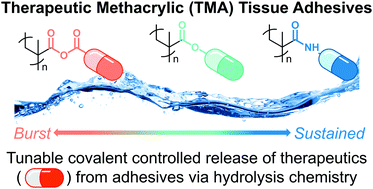当前位置:
X-MOL 学术
›
J. Mater. Chem. B
›
论文详情
Our official English website, www.x-mol.net, welcomes your
feedback! (Note: you will need to create a separate account there.)
Covalently-controlled drug delivery via therapeutic methacrylic tissue adhesives
Journal of Materials Chemistry B ( IF 6.1 ) Pub Date : 2017-08-30 00:00:00 , DOI: 10.1039/c7tb01151b Zoe M. Wright 1, 2, 3, 4, 5 , Brian D. Holt 1, 2, 3, 4, 5 , Stefanie A. Sydlik 1, 2, 3, 4, 5
Journal of Materials Chemistry B ( IF 6.1 ) Pub Date : 2017-08-30 00:00:00 , DOI: 10.1039/c7tb01151b Zoe M. Wright 1, 2, 3, 4, 5 , Brian D. Holt 1, 2, 3, 4, 5 , Stefanie A. Sydlik 1, 2, 3, 4, 5
Affiliation

|
Medical cyanoacrylate adhesives have the potential to eliminate the need for sutures but face challenges to widespread implementation due to their brittleness and release of formaldehyde upon degradation. To overcome these limitations, we used molecular design to create therapeutic methacrylic (TMA) monomers to impart tunable mechanical properties, decreased formaldehyde release, and covalently-controlled bioactivity to commercial cyanoacrylate adhesives. The small molecule therapeutics ibuprofen, acetaminophen, and benzocaine were covalently tethered to the carbonyl of methacrylate using anhydride, ester, and amide bonds. When these TMAs were incorporated into n-butyl cyanoacrylate (BCA) tissue adhesives, the resulting TMA–BCA materials provided release of the therapeutics across a range of time scales according to the reactivity of the tether bond to hydrolysis. The anhydride-tether TMA–BCA adhesive delivered ibuprofen on the same order of magnitude and time scale as topical medications (12 ± 6 mg per g adhesive after 3.4 h). TMA–BCA adhesives also produced less formaldehyde than standard BCA adhesive, showed promising cytocompatibility, and adhered effectively to porcine skin. Further, the anhydride, ester, and amide tether TMA–BCA adhesives exhibited a range of shear moduli, with those containing rigid aromatic amide groups being stiffer, and those with flexible alkyl segments being less stiff, which could enable these adhesives to be tailored to match the mechanical properties of target tissues. The amide-tether TMA–BCA adhesive also showed a 219% increase in toughness compared to BCA. Overall, TMAs represent a platform technology that can be used to build adaptable and bioactive tissue adhesives.
中文翻译:

通过治疗性甲基丙烯酸组织胶粘剂的共价控制药物输送
医用氰基丙烯酸酯粘合剂具有消除缝合的潜力,但由于其脆性和降解时甲醛的释放,面临着广泛实施的挑战。为了克服这些限制,我们使用分子设计来创建治疗性甲基丙烯酸(TMA)单体,以赋予商业氰基丙烯酸酯粘合剂以可调节的机械性能,减少的甲醛释放以及共价控制的生物活性。使用酸酐,酯和酰胺键将小分子治疗药布洛芬,对乙酰氨基酚和苯佐卡因共价连接到甲基丙烯酸酯的羰基上。当这些TMA合并到n中时氰基丙烯酸丁酯(BCA)组织粘合剂,所得的TMA–BCA材料根据系链键对水解的反应性,在一定的时间范围内释放了治疗剂。酸酐系绳TMA-BCA粘合剂以与局部用药相同的数量级和时间范围递送布洛芬(3.4 h后每克粘合剂12±6 mg)。TMA–BCA胶粘剂产生的甲醛也比标准BCA胶粘剂少,显示出有希望的细胞相容性,并有效粘附在猪皮肤上。此外,酸酐,酯和酰胺系绳TMA-BCA粘合剂表现出一定范围的剪切模量,其中含有刚性芳族酰胺基团的那些较硬,而具有柔性烷基链段的那些则较不硬,这可以使这些粘合剂适合匹配目标组织的机械性能。与BCA相比,酰胺系绳TMA-BCA粘合剂的韧性也提高了219%。总体而言,TMA代表了一种平台技术,可用于构建适应性强且具有生物活性的组织粘合剂。
更新日期:2017-09-15
中文翻译:

通过治疗性甲基丙烯酸组织胶粘剂的共价控制药物输送
医用氰基丙烯酸酯粘合剂具有消除缝合的潜力,但由于其脆性和降解时甲醛的释放,面临着广泛实施的挑战。为了克服这些限制,我们使用分子设计来创建治疗性甲基丙烯酸(TMA)单体,以赋予商业氰基丙烯酸酯粘合剂以可调节的机械性能,减少的甲醛释放以及共价控制的生物活性。使用酸酐,酯和酰胺键将小分子治疗药布洛芬,对乙酰氨基酚和苯佐卡因共价连接到甲基丙烯酸酯的羰基上。当这些TMA合并到n中时氰基丙烯酸丁酯(BCA)组织粘合剂,所得的TMA–BCA材料根据系链键对水解的反应性,在一定的时间范围内释放了治疗剂。酸酐系绳TMA-BCA粘合剂以与局部用药相同的数量级和时间范围递送布洛芬(3.4 h后每克粘合剂12±6 mg)。TMA–BCA胶粘剂产生的甲醛也比标准BCA胶粘剂少,显示出有希望的细胞相容性,并有效粘附在猪皮肤上。此外,酸酐,酯和酰胺系绳TMA-BCA粘合剂表现出一定范围的剪切模量,其中含有刚性芳族酰胺基团的那些较硬,而具有柔性烷基链段的那些则较不硬,这可以使这些粘合剂适合匹配目标组织的机械性能。与BCA相比,酰胺系绳TMA-BCA粘合剂的韧性也提高了219%。总体而言,TMA代表了一种平台技术,可用于构建适应性强且具有生物活性的组织粘合剂。











































 京公网安备 11010802027423号
京公网安备 11010802027423号